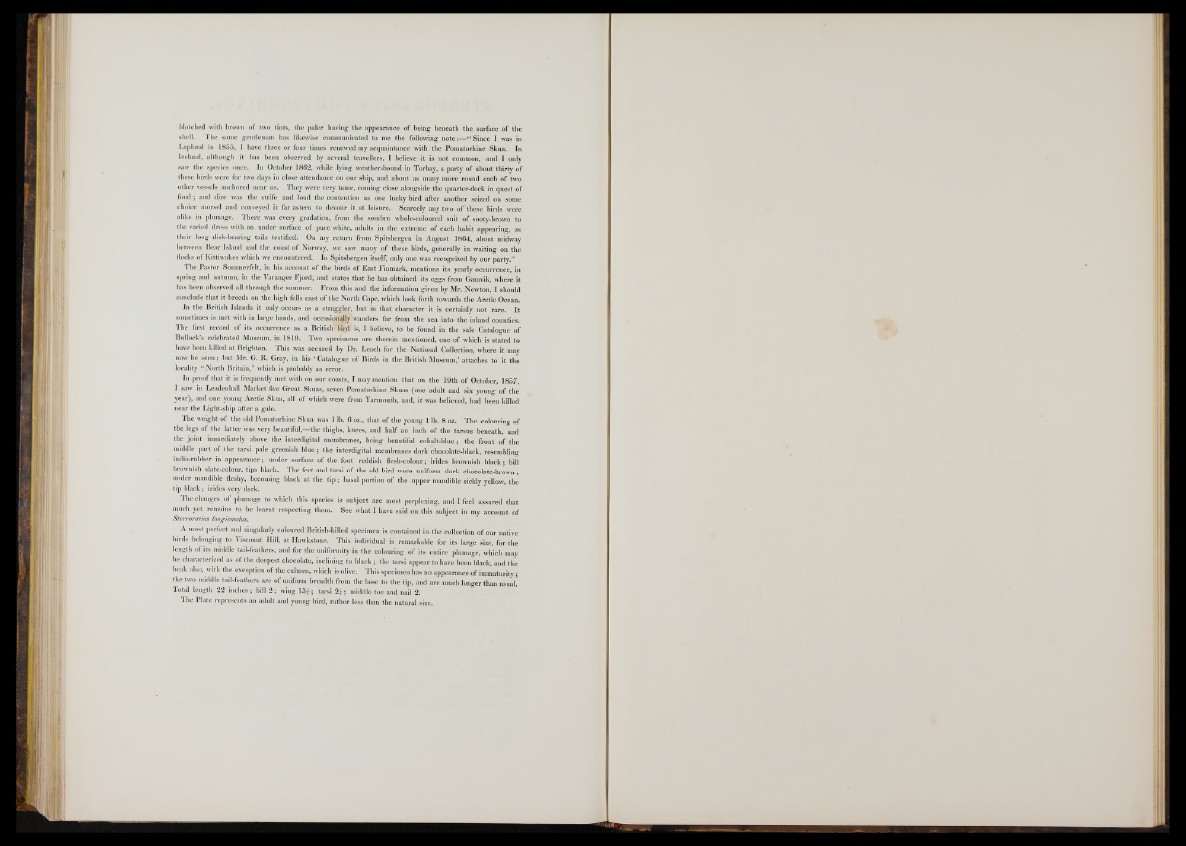
blotched with brown of two tints, the paler having the appearance o f being beneath the surface o f the
shell. The same gentleman has likewise communicated to me the following note:— “ Since I was in
Lapland in 1855, I have three or four times renewed my acquaintance with the Pomatorhine Skua. In
Iceland, although it has been observed by several travellers, I believe it is not common, and I only
saw the species once. In October 1862, while lying weather-bound in Torbay, a party o f about thirty o f
these birds were for two days in close attendance on our ship, and about as many more round each o f two
other vessels anchored near us. They were very tame, coming close alongside the quarter-deck in quest of
food ; and dire was the strife and loud the contention as one lucky bird after another seized on some
choice morsel and conveyed it far astern to devour it at leisure. Scarcely any two o f these birds were
alike in plumage. There was every gradation, from the sombre whole-coloured suit o f sooty-brown to
the varied dress with an under surface o f pure white, adults iu the extreme o f each habit appearing, as
their long disk-bearing tails testified. On my return from Spitsbergen in August 1864, about midway
between Bear Island and the coast o f Norway, we saw many o f these birds, generally in waiting on the
flocks of Kittiwakes which we encountered. Iu Spitsbergen itself, only one was recognized by our party.”
The Pastor Sommerfelt, in his account of the birds of East Finmark, mentions its yearly occurrence, in
spring and autumn, in the Varanger Fjord, and states that he has obtained its eggs from Gamvik, where it
has been observed all through the summer. From this and the information given by Mr. Newton, I should
conclude that it breeds on the high fells east o f the North Cape, which look forth towards the Arctic Ocean.
In the British Islands it only occurs as a straggler, but in that character it is certainly not rare. It
sometimes is met with in large bands, and occasionally Wanders far from the sea into the inland counties.
The first record of its occurrence as a British bird is, I believe, to be found in the sale Catalogue of
Bullock’s celebrated Museum, in 1819. Two specimens are therein mentioned, one o f which is stated to
have been killed at Brighton. This was secured by Dr. Leach for the National Collection, where it may
now be seen; but Mr. G. R. Gray, in his ‘ Catalogue o f Birds in the British Museum,’ attaches to it the
locality “ North Britain,” which is probably an error.
In proof that it is frequently met with on our coasts, I may mention that on the 19th o f October, 1857,
I saw in Leadenhall Market five Great Skuas, seven Pomatorhine Skuas (one adult and six youno- o f the
year), and one young Arctic Skua, all of which were from Yarmouth, and, it was believed, had been killed
near the Light-ship after a gale.
The weight o f the old Pomatorhine Skua was 1 lb. 6 oz., that o f the young 1 lb. 8 oz. The colouring of
the legs of the latter was very beautiful,—the thighs, knees, and half an inch of the tarsus beneath, and
the joint immediately above the interdigital membranes, being beautiful cobalt-blue; the front o f the
middle part of the tarsi pale greenish blue; the interdigital membranes dark chocolate-black, resembling
india-rubber in appearance; under surface o f the foot reddish flesh-colour; irides brownish black; bill
brownish slate-colour, tips black. The feet and tarsi of the old bird were uniform dark chocolate-brown ;
under mandible fleshy, becoming black at the tip ; basal portion of the upper mandible sickly yellow, the
tip black; irides very dark.
The changes of plumage to which this species is subject are most perplexing, and I feel assured that
much yet remains to be learnt respecting them. See what I have said on this subject in my account o f
Stercorarius longicaudus.
A most perfect and singularly coloured British-killed specimen is contained in the collection o f our ndtive
hirds belonging to Viscount Hill, at Hawkstone. This individual is remarkable for its large size, for the
length o f its middle tail-feathers, and for the uniformity in the colouring o f its entire plumage, which may
be characterized as o f the deepest chocolate, inclining to black ; the tarsi appear to have been black, and the
beak also, with the exception of the culmen, which is olive. This specimen has no appearance o f immaturity;
the two middle tail-feathers are o f uniform breadth from the base to the tip, and are much longer than usual!
Total length 22 inches; bill 2 ; wing 1 3 f; tarsi 2 | ; middle toe and nail 2.
The Plate represents an adult and young bird, rather less than the natural size.